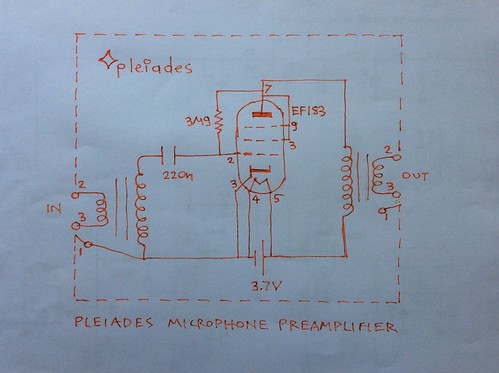Signal path, setup:
Male singing voice at 1-12in - Sennheiser MD441 U3 - Pleiades V6 with Altec 4722 input transformer and Cc=22nF - Sony TC-D5 Pro - Sennheiser HD580
Referring to the Pleiades V6 schematic:

Firstly the Nuvistor 7586 was disconnected and the EF183 pluged in. Heater is 3.9V. Initially plate supply is 1.3V. The 7586 gave a very low anode current, possibly 3μA but very nice sound.
Very nice sound with the EF183 too. Anode current is a healthy 10μA. Anode to grid bias resistor is 6MΩ.
Next the Pleiades bias or pull up restor was disconnected, the grid left floating or at space potential and 9V applied at the plate or anode.
Great sound. There is something dynamic about open grid. Anode current was a healthy 20μA.
Next an anode to grid resistor of 18MΩ was connected from anode to grid. Anode current jumped to more than 300μA.
The sound was big and treble detailed but perhaps more ordinary. Very low noise performance could be observed by short circuiting the input capacitor while the input transformer primary was linked by a short circuit male XLR. (A further big difference in noise decrease could be observed by shorting from secondary to ground). Nevertheless the far away ticking clock could be heard even when the anode current was 20μA.
While the anode current was at 300μA the heater was disconnected while listening and then reconnected. A maximum clock tick could be distiguished at about 70μA. Is bandwidth related to this? By using a 10Ω series resitor thereby further underheating cathode the max anode current was approx 150μA with an 18MΩ pull up bias resistor or Pleiadss bias resistor from anode to grid.
The big difference in sound between 300μA by pull up bias and 20μA by open grid was somewhat reduced bass and treble at 20μA making for possibly a more natural sound. Possibly due to equal loudness Flecher Munson curves, voice effort curves and proximity compensation. Nevertheless the high end extension while at Ia=300μA was joyful too on such a brilliant mic as on Sennheiser MD441 there are no s problems etc. At 300μA operation the Pleiades 130Ω,40mH low slope bass cut filter was connected between mic and V6 headamp. The singer could aproach the mic much closer, at 1in. The sound was very bright and clear.
Next at open grid conditions 12V were applied to the plate by taking advantage of the series addition of heater potential and Vb. The anode current jumped to 50μA. But the 10μA sound was prepared. There was some order or harshness or mid unbalance.
How would UF89 sound like powered by just a 9V battery for both heaters with open grid or a variable anode to grid pull up or Pleiades Bias resistor?
The conclusions are yours.
One hour later addition: since there were various positive potentials lying around at the breadboard at this stage it was very easy to connect the 18MΩ grid return to them in turn and listen to what happens:
Keeping plate potential 9V (by the 9V battery in series with a fuse for safety) the 18MΩ was connected to cathode. Cathode as we know is some hundred millivolts positive with respect to grid so this again is pull up bias making the grid less negative. Anode current jumped to 70μA. A very nice and perhaps the lowest noise of all. It is interesting to hear the gain of the EF183 gradually increase as anode current is increased as if a compressor release time. The clock could be heared clearly.
Next the resitor was connected to heater 4V. Treble somewhat increased, anode current at about 200μA. Then the 18MΩ resitor connected to 9V plate as before, Ia to 400μA and even more treble and somewhat more strained and manipulated sound.
Next all the way down in anode current to cathode pull up bias and then to open grid giving Ia=20μA. Nice big sound, less but natural treble somewhat less low noise despite off treble decreasing. One is temped to choose the 70μA anode current option with cathode pull up bias. It may remind of the sound at 4V plate potential and 6MΩ from anode to grid pull up bias giving again an anode current of 70μA.
So it seems it does not matter how one gets there but anode current is important for sound and an optimum value for the particular setup giving neither to bass or treble heavy sound, nice mid, and low noise is 70μA.
With 70μA flowing to the anode of an electron tube one can certainly feel rich.
No comments:
Post a Comment